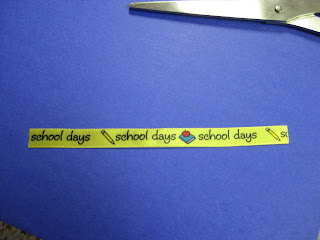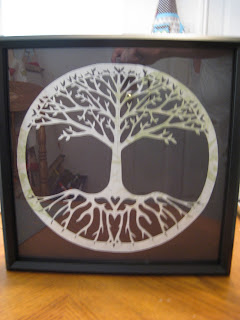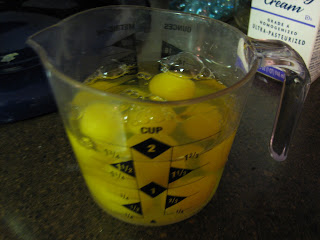My mom has taught me many things in life. Too many things to list here. But as a military wife, my mom is one of the most adaptable people I know, and she does it not by simply acclimating to her surroundings, but by assimilating
into them. Every time we moved, she learned about the place we were living and strove to make us a part of our new home rather than strangers just living there. She learned about local foods and made them for us, took us to festivals and cultural events and really made every place we were ever stationed another hometown for us.
So it happened that, being a military wife, I found myself living in Germany, twenty minutes from the French border. I learned about the food, about the culture and the history, I learned the language - well, I already knew the language, but I learned the dialect - and I was just missing something. As a crafty person, I needed something to take away from my time in the DE. And that's why I taught myself the art of Scherenschnitte.
Scherenschnitte is the art of cutting paper, and has very strong roots in Germanic history. Actually, many cultures have a paper cutting history - the Chinese and the Mexicans spring to mind. Beautiful scherenschnitte pieces can be found in museums and small shops in Germany, and that's where I was introduced to this amazing art. I remember finding a piece that was a farmhouse, several stories tall, with views into each of the floors and animals and an apple tree in the yard. It was so detailed and amazing, I just knew that I had to learn how to make these fragile, delicate lace-like pieces of paper.
Patterns for paper cutting abound online. You can print off a pattern for almost anything you can think of. But there's no challenge in that - it's like filling in a coloring book and calling it an original work. No sir. Not for me. So I began drawing out scherenschnitte patterns of my own - pieces that spoke to me and about me. Things for my friends and for my children. I started out using scrapbook paper and an exact-o knife, and graduated to handmade papers, archival quality glue and a craft knife with a very delicate, razor sharp tip. I now have punches, razor guides, fingertip blades and all sorts of neat little bits and pieces for paper cutting, but I rarely use them. I prefer to do it the old fashioned way, with scherenscnitte scissors and a knife, and hand drawn patterns.
The Tree of Life is a very old, very strong symbol in Scottish culture. It represents heaven and earth, the mortal plane and life itself. Originally depicted by knotwork, they now often resemble Rowan trees. It is a special, personal piece of myself that I really enjoy giving to other people, and a cutting I've done often for friends.
This is one of my first Tree of Life cuttings that I made, and this one was for my friend Amanda. She wasn't able to take it with her when she moved, and I never got it to her because the glass broke, as you can see, and I've just never gotten around to sending it to her. Sorry! I promise to get on it!
I've learned so much since this cutting, and I was itching to draw out a new pattern, so for Jennifer's housewarming, I decided to design a new tree of life, just for her. Now, I haven't done a cutting since I left Germany. One of the medicines I take gives me a terrible case of the shakes, so much so that I take an anti-parkinsons medication to control them. Recently though, I started a new med that has helped decrease the shakes even more, so I'm finally able to do work that requires fine-motor control again. Yay! This is the first piece I've done in two years, so please cut me a little slack when you see it.
Don't you just love this paper? It's handmade, with real leaves (and dirt) pressed into it. I've been saving it for something special, because it's so beautiful that I just didn't want to cut into it.
My first step was to cut a piece of the paper out that was sized to my pattern. I decided to give up about two inches around the edge in order to center my pattern on that gorgeous leaf. For the sake of full disclosure, this is not the piece I actually used. I decided to enlarge the pattern and so I had to cut another piece to fit the larger size. But of course, I neglected to take a picture.
Here's my pattern. It's symmetrical, so I folded the paper in half and lined my pattern up with the edge, then taped it down. If your tape is going to touch a part of the paper that will not be cut away, touch your finger to the sticky side a few times to lessen the stickiness of the tape. You don't want it to ruin your piece when you pull it off later.
Now I start cutting. Start with the details and leave the big pieces until last. Always pull, never push. And be very careful - one slip and you've severed a piece that connects the whole design. But if that happens, don't panic - you can apply a small piece of tape to the back of the cutting and trim off the excess tape with your knife. No one will ever know. Trust me, I've done it a thousand times, especially with delicate paper.
Always cut the piece away from the paper last. The big expanses of paper provide stability and give you a place to hold on to the piece while you cut.
And let me just say, this gorgeous paper was a dream to cut, except that it was very fibrous, and tufts of fibers pulled away from the paper every time I picked up my knife. It was very weird.
Carefully remove your pattern. If you have a very detailed portion with lots of loose ends, like the top of this tree with the leaves, your pattern might get tangled up, so go slowly. It's not a race. Well, sometimes it is, but usually not.
Ta da! But you're not done, not even close. Sorry to get your hopes up, I guess that was a premature ta da.
See those tufts of fibers in the corners there? It's time to clean those up. Use the tip of your knife to slice them away and give your piece nice, straight corners and unbroken lines. This takes just about as long as cutting the piece in the first place. It's a little ridiculous, but it's also the difference between a piece of art and a paper snowflake.
That's much better. But you can see that I accidentally tore one of the root pieces. I taped it from behind and like I said, no one would ever know except that I just told the whole world.
Unless you can find one of those really awesome clear glass plate frames, you'll need a background piece. I usually like to mount on hand painted watercolors, but with the variegations in the paper, I thought it would just be too much. Which is a shame, because I love painting with water colors so much. It's very therapeutic.
This is the cutting on the background paper that I picked out. You can see that it's a little darker than the paper in the last picture - I just couldn't get behind that shade of brown. It looked a little cheap and gross to me. But then again, I am really picky about this sort of thing.
And here's the finished piece all framed up and ready to give to Jennifer and Talon! I think it turned out very well. See the little heart in the roots? And the way the tips of the branches and roots go negative in the border? I just love it. And so you don't think that this came purely from my brilliant imagination, I think I looked at a dozen pages of Tree of Life images and this design is an amalgamation of every one that I saw and liked.
I'll try to post pictures of a few other pieces that I drew out and cut later - there are a few framed around my house and many, many more in my paper cutting craft tote and tucked into my cutting mats. I hope that you like them, and that this encourages you to try it for yourself.
PS - Just so you don't think this is some amazing feat of craftiness that you could never do yourself, you should know that I researched, drew and cut this while watching Mission Impossible: Ghost Protocol with Husband last night. I'm just saying. If I can, you can.



























































